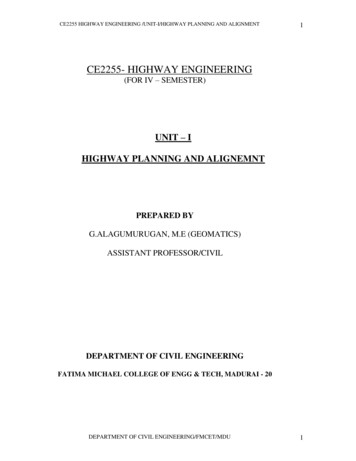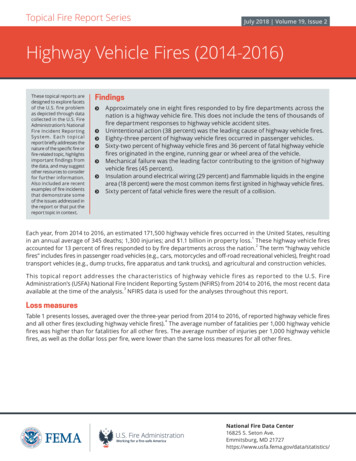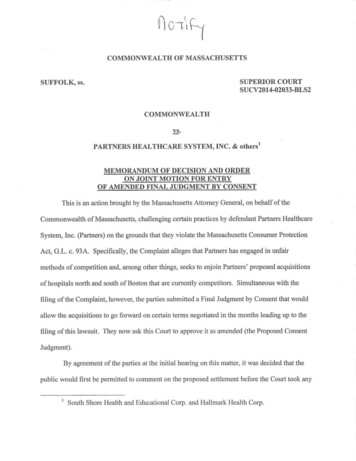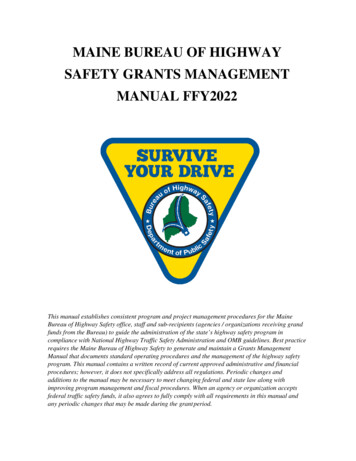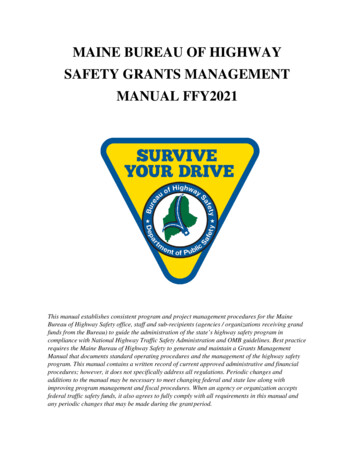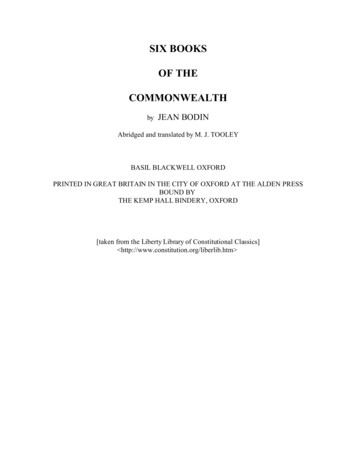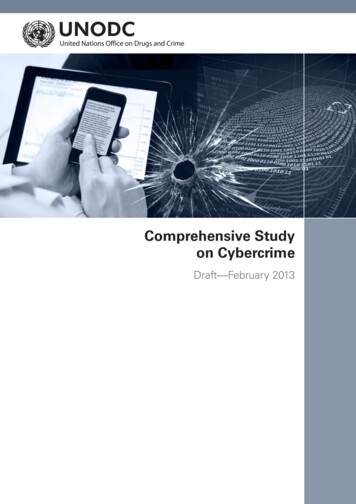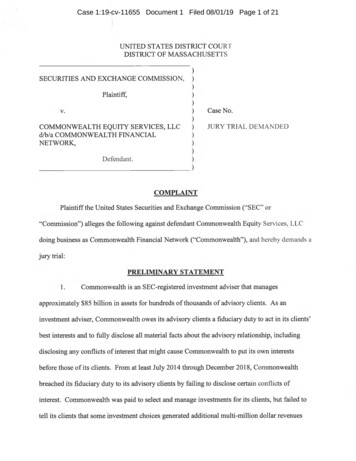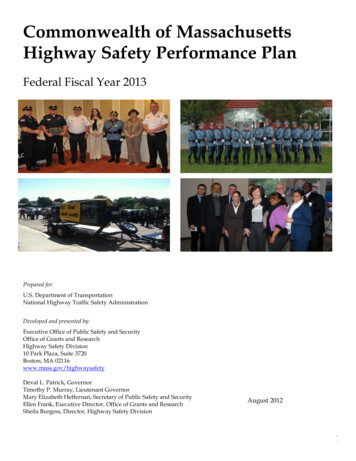
Transcription
Commonwealth of MassachusettsHighway Safety Performance PlanFederal Fiscal Year 2013Prepared for:U.S. Department of TransportationNational Highway Traffic Safety AdministrationDeveloped and presented by:Executive Office of Public Safety and SecurityOffice of Grants and ResearchHighway Safety Division10 Park Plaza, Suite 3720Boston, MA 02116www.mass.gov/highwaysafetyDeval L. Patrick, GovernorTimothy P. Murray, Lieutenant GovernorMary Elizabeth Heffernan, Secretary of Public Safety and SecurityEllen Frank, Executive Director, Office of Grants and ResearchSheila Burgess, Director, Highway Safety DivisionAugust 2012Au
Commonwealth of MassachusettsAcknowledgmentsThe Federal Fiscal Year (FFY) 2013 Massachusetts Highway Safety Performance Plan(HSPP) recognizes that traffic crashes are preventable and that Massachusetts iscommitted to continuously reducing the number of fatalities, injuries, and economic lossesresulting from these crashes.I acknowledge the contributions and thank the staff of the Executive Office of PublicSafety and Security (EOPSS), Office of Grants and Research (OGR), Highway SafetyDivision (HSD) for their efforts in the development and implementation of this HSPP:Sheila Burgess, DirectorCynthia Campbell, Senior Program ManagerCaroline Hymoff, Senior Program ManagerDaniel DeMille, Program Coordinator IIIDeborah Firlit, Program Coordinator IIRobert Kearney, Program Coordinator IIEmma Morrison, Program Coordinator IIBarbara Rizzuti, Program Coordinator IIISusan Burgess-Chin, Fiscal SpecialistDenise Veiga, Accountant IVThe hard work and dedication of EOPSS/HSD staff on the issues of highway safety havecontributed significantly to safer roadways in Massachusetts, including a 22 percentincrease in the safety belt usage rate between 2002 and 2012 and a 20 percent decrease inthe number of fatalities involving a driver or motorcyclist operating with a Blood AlcoholConcentration (BAC) of at least .08 from 2006 to 2010. I look forward to working withHSD staff and the many others involved in highway safety to improve upon theseaccomplishments.Mary Elizabeth HeffernanSecretaryExecutive Office of Public Safety and Security
Commonwealth of MassachusettsThis Page Intentionally Left Blank
Commonwealth of MassachusettsTable of Contents1.0 Introduction .1.1 HSPP Calendar .1.2 Executive Office of Public Safety and Security, Office of Grants andResearch, Highway Safety Division Organization .1.3 Mission Statement .1.4 Highway Safety Program Overview .1-21-21-32.0 Highway Safety Problem Identification .2.1 Problem Identification Process .2.2 Massachusetts Characteristics .2.3 Normalizing Data and Major Statistics .2.4 FFY 2013 Goals .2.5 Program Areas .2-12-12-32-42-212-243.0 Impaired Driving Program Area.3-14.0 Occupant Protection Program Area .4-15.0 Speed and Distracted Driving Program Area .5-16.0 Higher Risk Transportation System Users Program Area .6.1 Young and Older Drivers.6.2 Pedestrians and Bicyclists .6.3 Motorcyclists .6-16-16-36-87.0 Traffic Records Program Area .7-18.0 Additional Program Areas .8.1 Police Traffic Services Program Area .8.2 Planning and Administration Program Area.8-18-18-49.0 Certifications .9.1 State Certifications and Assurances .9-19-110.0 Highway Safety Plan Cost Summary .10-1Executive Office of Public Safety and Security – Highway Safety Division1-11-1i
Commonwealth of MassachusettsList of Tables2.1 Data Used for FFY 2013 HSPP Problem Identification .2.2 Counties of Massachusetts.2.3 Base Data for Massachusetts and United States .2.4 Massachusetts Crash Data Trends .2.5 Additional Massachusetts Crash Data Trends.2.6 FFY 2013 Goals .3.1 Persons Killed by Highest Driver Blood Alcohol Content in Crash inMassachusetts .3.2 Persons Killed by Highest Driver BAC in Crash by BAC in Massachusetts .3.3 Massachusetts Alcohol-Related Violations .3.4 Massachusetts Alcohol-Related Arrests.3.5 Massachusetts Drug-Related Arrests .4.1 Massachusetts Safety Belt Use Rates .4.2 Massachusetts Safety Belt and Child Safety Seat Violations .4.3 Intercept Survey Results .5.1 Massachusetts Speed-Related Fatalities.5.2 Massachusetts Speeding Violations .6.1 Young and Older Driver Fatalities and Incapacitating Injuries inMassachusetts .6.2 Key Findings from Health and Risk Behavior Survey of Massachusetts Youth .6.3 Massachusetts Pedestrian Fatalities and Incapacitating Injuries .6.4 Massachusetts Bicyclist Fatalities and Incapacitating Injuries .6.5 Massachusetts Motorcyclist Fatalities and Incapacitating Injuries .10.1 Highway Safety Plan Cost Summary .10.2 Acronym Glossary 26-16-26-46-56-810-210-3
Commonwealth of MassachusettsList of .132.144.16.1Highway Safety Division Organizational Chart.Fatalities.Fatality Rate .Serious Injuries .BAC 0.08 Driver Fatalities .Unrestrained Passenger Vehicle Occupant Fatalities .Speeding-Related Fatalities .Motorcyclist Fatalities .Unhelmeted Motorcyclist Fatalities.Young Drivers (Age 20 or Younger) Involved in Fatal Crashes.Pedestrian Fatalities .Observed Seat Belt Use .Percent of Massachusetts Fatal Crashes by Month-of-Year .Percent of Massachusetts Fatal Crashes by Day-of-Week.Percent of Massachusetts Fatal Crashes by Time-of-Day.Safety Belt Use for Vehicle Occupants Involved in Massachusetts and U.S.Fatal Crashes .Junior Operator Law License Violations .Executive Office of Public Safety and Security – Highway Safety 172-192-202-204-36-2iii
Commonwealth of MassachusettsThis Page Intentionally Left Blank
Commonwealth of Massachusetts1.0 Introduction 1.1 HSPP CalendarJanuary to MarchHSD reviews progress of FFY 2012 programs with senior staff at EOPSS;analyzes federal, state, and local data to identify FFY 2013 key programareas; reviews National Highway Traffic Safety Administration (NHTSA)Region I response to the FFY 2012 HSPP, FFY 2011 Annual Report, recentNHTSA assessments, and Regional Action Plan; reviews spendingpatterns and revenue estimates.January to MaySenior staff at EOPSS/HSD conducts strategic planning/meetings withkey stakeholders to present recent data analyses and discuss the issuesfacing their communities. EOPSS/HSD reviews proposals for fundingconsideration resulting from the website posting at www.mass.gov/highwaysafety. EOPSS/HSD also generates its own project proposals forreview and acceptance.May to AugustHSD drafts the FFY 2013 HSPP for review and approval by senior staff atEOPSS. HSD conducts pre-submission meeting with NHTSA Region I.HSD obtains any updates to previously reviewed federal, state, and localdata and analyses. With approval of senior staff at EOPSS, HSD submitsthe final plan to NHTSA and the Federal Highway Administration(FHWA).SeptemberEOPSS/HSD begins to issue Requests for Responses/Quotes (RFR/RFQ)and Availability of Grant Funding (AGF) applications in anticipation ofNHTSA’s approval of the HSPP.OctoberEOPSS/HSD begins to implement and award grants and contracts andthen begins work on the FFY 2012 Annual Report.November toDecemberEOPSS/HSD oversees grants and projects in the HSPP, finalizes the FFY2012 Annual Report, and submits it to NHTSA.Executive Office of Public Safety and Security – Highway Safety Division1-1
Commonwealth of Massachusetts 1.2 Executive Office of Public Safety and Security,Office of Grants and Research, Highway SafetyDivision OrganizationFigure 1.1 Highway Safety Division Organizational ChartSheila BurgessDirectorCindy CampbellSenior ProgramManagerDan DeMilleProgramCoordinator IIICaroline HymoffSenior ProgramManagerBob KearneyProgramCoordinator IIDeb FirlitProgramCoordinator IIBarbara RizzutiProgramCoordinator IIIVacantProgramCoordinator IIEmma MorrisonProgramCoordinator II 1.3 Mission StatementThe mission of EOPSS/HSD is to facilitate the development and implementation ofpolicies, programs, and partnerships to help reduce fatalities, injuries, and economic losses1-2Executive Office of Public Safety and Security – Highway Safety Division
Commonwealth of Massachusettsresulting from motor vehicle crashes on the roadways of the Commonwealth ofMassachusetts. HSD administers the federally and non-federally funded highway grantprograms of EOPSS. 1.4 Highway Safety Program OverviewWithin the Commonwealth of Massachusetts, HSD is responsible for planning,implementing, and evaluating highway safety projects with federal funds. HSD alsoworks to coordinate the efforts of federal, state, and local organizations involved withhighway safety in Massachusetts.This HSPP for FFY 2013 serves as the Commonwealth of Massachusetts’ application toNHTSA for federal funds available under the Moving Ahead for Progress in the 21stCentury (MAP-21) transportation bill. The HSPP also reflects programs that will beconducted with grant funds previously received but unspent under the Safe, Accountable,Flexible, and Efficient Transportation Equity Act: A Legacy for Users (SAFETEA-LU).Other sources of funds include cooperative agreements with NHTSA for the FatalityAnalysis Reporting System (FARS) project, the Grant to Increase the Number of ProperlyEndorsed Motorcyclists, the Grant to Increase BAC Reporting, and private funds donatedto the Highway Safety Trust Fund.To identify the issues to be addressed in the FFY 2013 highway safety program,EOPSS/HSD relied primarily on 2006 to 2010 trend data, and, whenever possible, also2011 data. Data from 2011 was largely unavailable due to staffing shortages at the Registryof Motor Vehicles (RMV). Also note that 2010 and most 2011 data provided in this reportare preliminary and subject to change. The changes in the total number of crashes andother data in recent years is in part attributable to different reporting rates by differentpolice jurisdictions, but also to the declining number of operator-only reports (reportssubmitted by motorists who are involved in crashes, for which no police report wassubmitted) that were entered in the crash data system by the RMV in recent years.EOPSS/HSD has performed outreach to police departments to improve the accuracy andtimeliness of crash reporting.The program planning throughout this HSPP maybe altered depending on how MAP-21 isimplemented. EOPSS/HSD will submit anychanges to the approved HSPP to Region 1 forreview and approval.Executive Office of Public Safety and Security – Highway Safety Division1-3
Commonwealth of MassachusettsFFY 2012 Highlights EOPSS/HSD’s June 2012 statewide safety belt observation survey using the newNHTSA methodology showed that Massachusetts maintained the 73 percent usage rateobserved in 2011. EOPSS/HSD, in partnership with state and local law enforcement and a mediacontractor, implemented its public outreach and enforcement of Click It or Ticket (CIOT)and Drive Sober or Get Pulled Over (DSGPO) Mobilizations. EOPSS/HSD changed to adata-based eligibility process for traffic enforcement grants in FFY 2012. As a result,participation by local police departments decreased from 189 in 2011 to 128 in 2012. During spring 2012 EOPSS/HSD, along with government and corporate partners,conducted a safe prom and graduation video contest, Dance. Don’t Chance. Thecenterpiece of the initiative was a contest for high school students to submit 60-secondvideos with messages about safe, sober, distraction free driving all year, but especiallyduring prom and graduation season. The 49 video submissions were available forviewing and voting online and the winning videos from Weston and Wilmington HighSchools were highlighted at a public event. Over 70,000 people viewed the videos onYouTube. EOPSS/HSD secured prizes for contest winners valued at approximately 7,000. EOPSS/HSD received 50,000 from NHTSA, through MDavis & Company, for ademonstration project to reduce impaired motorcycle riding and associated crashesthrough the use of High Visibility Enforcement. The Massachusetts State Police (MSP)will participated in two saturation patrols in Lowell and conduct two sobrietycheckpoints in Springfield. EOPSS/HSD, in cooperation with the RMV, conducted a Motorcycle Safety Conferencein May for approximately 100 law enforcement representatives. Topics included crashdata, licensing, motorcycle laws, operating under the influence, and distinguishingbetween types of vehicles (mopeds, limited use vehicles, motorized scooters, etc.). EOPSS/HSD joined with the Massachusetts Department of Transportation (MassDOT)and the MSP to kickoff the second statewide Work Zone Speed Enforcement Campaignin April 2012. The campaign goal is to actively deploy “zero tolerance” MSP details atconstruction sites around the state to strictly enforce speed limits through work zones.This is in direct response to the deaths and injuries of MSP troopers in work zones. Inaddition to monitoring speed violations and impaired driving, the enforcement activityalso focused on identifying and citing any violators. The initial campaign started inNovember 2011 and ran for a period of 10 weeks resulting in 3,600 traffic stops forviolations within work zones of which nearly 2,000 were for speeding. Motorists werealso cited for “move over law” violations as well as distracted driving infractions. Thenighttime deployments of these details also resulted in several arrests for operatingunder the influence of alcohol. Increased enforcement corresponds with placing signs1-4Executive Office of Public Safety and Security – Highway Safety Division
Commonwealth of Massachusettsand placards at RMV branch offices, mass transit train cars and on variable messageboards along highways promoting the initiative. With assistance from its traffic records contractor, the Massachusetts Traffic RecordsCoordinating Committee (TRCC), the Massachusetts Executive-Level Traffic RecordsCoordinating Committee (METRCC), and NHTSA Region I, HSD submitted anapplication for FFY 2012 Section 408 funding. Applications also were submitted for FFY2012 Sections 403, 2010, 2011, 405, and 410 funding. New funding is not available fromOJJDP this year. To recognize traffic safety accomplishments of state and localpolice, EOPSS/HSD conducted the Massachusetts LawEnforcement Challenge (MLEC) in cooperation with theMassachusetts Chiefs of Police Association (MCOPA). Theceremony, based on 2011 data, was held in August andrecognized 23 local police departments and the MSP.EOPSS/HSD secured prizes from vendors valued atapproximately 30,000.AAA materials at MLEC With the goal of promoting communication and better understanding between lawenforcement and local communities, EOPSS/HSD developed and launched the Fair andImpartial Policing (FAIP) website at www.mass.gov/eops. FAIP is a web-basedinitiative designed to give Massachusetts law enforcement professionals and membersof the community new insight into the issue commonly referred to as “racial profiling.”The FAIP training modules, developed with Section 1906 funding, are accessible at nocost. Translations are available in Spanish, Portuguese, French Creole, Cape Verdean,Arabic, Khmer, Vietnamese and Chinese. Trainings will be available for lawenforcement officials through the Municipal Police Training Committee (MPTC). Theinitiative was highlighted in the Governors Highway Safety Association State HighwaySafety Showcase and was submitted to the International Association of Chiefs of Policefor national outreach. EOPSS/HSD hosted two Data-Driven Approaches to Crime and Traffic Safety(DDACTS) Implementation Workshops for the MSP and approximately 20 municipalpolice departments. Massachusetts law enforcement officials also attended a workshopin Rhode Island.PartnershipsEOPSS/HSD is involved in many partnerships to enhance highway safety inMassachusetts including: EOPSS-led METRCC EOPSS-led TRCCExecutive Office of Public Safety and Security – Highway Safety Division1-5
Commonwealth of Massachusetts MassDOT-led Strategic Highway Safety Plan Executive Leadership Committee MassDOT-led Work Zone Safety Committee Department of Public Health (MDPH)-led Massachusetts Prevent Injuries Now!Network (PINN) MDPH-led Partnership for Passenger Safety Committee RMV-led Impaired Driving Advisory Board RMV-led Junior Operator License Advisory CommitteeThe In-Control Crash Prevention team at their booth atthe No Distractions - Just Drive event1-6Executive Office of Public Safety and Security – Highway Safety Division
Commonwealth of Massachusetts2.0 Highway Safety ProblemIdentificationThis HSPP for FFY 2013 has been developed in coordination with the following plans: Massachusetts’ Strategic Highway Safety Plan (2006 and 2012 draft) NHTSA’s Region I Action Plan (FFY 2011 and FFY 2012) NHTSA’s Impaired Driving Assessment for Massachusetts (FFY 2005) NHTSA’s Occupant Protection Assessment for Massachusetts (FFY 2007) NHTSA’s Occupant Protection Special Management Review (FFY 2009) NHTSA’s Motorcycle Safety Program Technical Assessment (FFY 2010) Massachusetts Statewide Electronic Data Capture System (formerly e-citation) andTraffic Records System Business Plan (FFY 2009) Massachusetts’ Section 408 Application/Strategic Traffic Records Plan Update (2012) NHTSA’s Massachusetts Traffic Records Assessment Report for Massachusetts (2009) NHTSA’s Standardized Field Sobriety Test (SFST) Assessment Report forMassachusetts (2012) NHTSA’s Countermeasures That Work Volume Six Centers for Disease Control’s Community Guide Pacific Institute for Research and Evaluation’s Best Practice Guide 2.1 Problem Identification ProcessEOPSS/HSD used a variety of data sources presented in Table 2.1 to pinpoint areas ofconcern warranting attention from Massachusetts highway safety professionals in FFY2013. The process is outlined below. General Problem Identification. This step begins by identifying the data sources usedto identify problems and the persons or organizations responsible for collecting,managing, and analyzing relevant data. These data sources are described in Table 2.1.Results of the data are then analyzed and weaknesses are identified. This step also usesExecutive Office of Public Safety and Security – Highway Safety Division2-1
Commonwealth of Massachusettsongoing exchanges and listening sessions with key federal, state, and local partners toidentify major highway safety areas of concern. The information is also used forguiding subsequent analyses. Selection of Program Areas. This step uses analyses of available data sources toconfirm the general decisions regarding major areas of concern made in the first step.EOPSS/HSD continues to collaborate with partners and safety stakeholders to gaininput and agreement about the problem areas. Focus is not only on the size andseverity of the problem but also where the greatest impact in terms of reducingcrashes, injuries and fatalities can be made. Project selection criteria is established withthe help of partners. Determination of Goals, Performance Measures, and Tasks. During this step, all ofthe above work is used to set reasonable goals, objectives, performance measures, andto develop tasks for the program areas in order to allocate EOPSS/HSD’s limitedresources where they can be most effective. This step requires a deep knowledge of thedemographics, laws, policies, and partnering opportunities and limitations that exist inthe Commonwealth. Selected programs and projects are explicitly related to theaccomplishment of performance goals.Table 2.1Data Used for FFY 2012 HSPP Problem IdentificationData TypeData SetSource/OwnerYear(s)ExaminedFatalityFARSNHTSA, State Traffic SafetyInformation (STSI)2006 to 2010Crash Fatalityand InjuryMassachusetts Crash Data SystemRMV, Merit Rating Board(MRB), STSI2006 to 2010ViolationMassachusetts Citation DataRMV, MRB2007 to 2011Safety Belt UseMassachusetts Safety Belt UseObservation DataEOPSS/HSD2002 to 2012Licensed Drivers,Registrations andVehicle MilesTraveled (VMT)Highway StatisticsFHWA, U.S. Census Bureau,RMV2006 to 2009Driving Underthe InfluenceCrime StatisticsMRB, Federal Bureau ofInvestigation2006 to 2010Safety Belt AttitudeIntercept SurveyEOPSS/HSD2009 to 2010The crash data used in this HSPP may not be consistent with the data reported byNHTSA’s FARS due to variations in data availability and to data quality improvements.2-2Executive Office of Public Safety and Security – Highway Safety Division
Commonwealth of Massachusetts 2.2 Massachusetts CharacteristicsMassachusetts is the 6th smallest state with a land area of approximately 10,555 squaremiles and 351 cities and towns. Despite its small geographic size, Massachusetts is the 14thmost populated state. According to the U.S. Census, in 2010, theCommonwealth’s estimated population was 6,547,629, resulting ina density of approximately 620 persons per square mile.Massachusetts is the most populous of the six New England states.The highest population concentrations are in the eastern third ofthe state. In addition to the high concentration around the statecapital and most populous city in the east, Boston, smaller pocketsof population density also exist around the second and third largestcities, Worcester in central Massachusetts and Springfield inSecretary Heffernan speakingwestern Massachusetts.at an MSP eventBased on the most recently available RMV information, in 2012 there are 4,722,120 licenseddrivers. Other demographic facts for Massachusetts based on 2010 U.S. Census Bureaudata include: Age distribution:ochild (under 18 years old) 22 percentoadult (18 to 64 years old) 64 percentoolder persons (65 ) 14 percent Non-Caucasians account for 19.6 percent of the population compared with 27.6 percentnationally The three largest minority race populations in Massachusetts as of 2010 are Hispanic orLatino (9.6 percent), African Americans (6.6 percent), and Asians (4.7 percent)The Massachusetts economy has become increasingly reliant on academic/research,tourism, technology, and financial services and less reliant on the manufacturing industry.Tourist destinations on Cape Cod and in the Berkshires as well as over 120 public andprivate colleges and universities create significant seasonal increases in the population bothstatewide and regionally. County government is virtually non-existent except as geographicdefinitions. In general, at the local level, administrative and legislative powers rest withmayors and city councils, town managers, town administrators, and boards of selectmen.The counties detailed in Table 2.2 have been used in this HSPP for purposes of localizing thetraffic safety statistics.Executive Office of Public Safety and Security – Highway Safety Division2-3
Commonwealth of MassachusettsTable 2.2CountyCounties of Massachusetts2010 County Population Estimates,per U.S. Census BureauCounty2010 County Population Estimates,per U.S. Census ster798,552To accommodate the travel demands of this population, Massachusetts has a roadwayinfrastructure consisting of over 36,000 miles of public roadway, including portions of 13interstates with 573 miles. The major roadways include Interstates 90 (the MassachusettsTurnpike), 91, 93, 95, and 495. In 2010, motorists in Massachusetts traveled over 54 billionmiles. 2.3 Normalizing Data and Major StatisticsThe values identified in Table 2.3 are used in the remainder of the report to normalizeMassachusetts and national safety data.2-4Executive Office of Public Safety and Security – Highway Safety Division
Commonwealth of MassachusettsTable 2.3Base Data for Massachusetts and United MAU.S.Population 73,087VMT ,76554.36229,665Licensed Drivers otal FatalitiesSource: U.S. Census May 2011; RMV July 2012; FHWA May 2011; NHTSA Traffic Safety Facts 2004 to 2009; FARS May 2012Key Massachusetts crash data and trends are provided in Table 2.4Table 2.4Massachusetts Crash Data TrendsCrash alities (Actual)459462476441429434364340347Fatality Rate/ (100 Million 5,0335,0524,5794,1823,9833,3843,835Number of Fatalities Involving Driver orMotorcycle Operator w/ .08 BAC178156169148144155120106115Number of Unrestrained Passenger VehicleOccupant Fatalities18917716517115814812211692Number of Speeding-Related Fatalities176156158145148143977768Number of Serious InjuriesExecutive Office of Public Safety and Security – Highway Safety Division2-5
Commonwealth of MassachusettsTable 2.4Massachusetts Crash Data Trends (continued)Crash 560565062425255N/ANumber of Unhelmeted Motorcyclist Fatalities549453166N/ANumber of Drivers Age 20 or 66764658N/A51%62%63%65%67%69%67%74%74%73%Number of Seat Belt Citations Issued DuringGrant-Funded Enforcement Activities*––––10,613 22,46312,21616,15913,8156,118Number of Impaired Driving
Commonwealth of Massachusetts Highway Safety Performance Plan Federal Fiscal Year 2013 . Prepared for: U.S. Department of Transportation . National Highway Traffic SafetyAdministration . Developed and presented by: Executive Office of Public Safety and Security .
